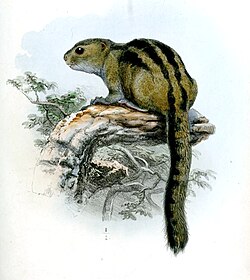| African striped squirrel | |
|---|---|
 | |
| Lady Burton's rope squirrel (Funisciurus isabella) | |
| Scientific classification | |
| Kingdom: | Animalia |
| Phylum: | Chordata |
| Class: | Mammalia |
| Order: | Rodentia |
| Family: | Sciuridae |
| Subfamily: | Xerinae |
| Tribe: | Protoxerini |
| Genus: | Funisciurus Trouessart, 1880 |
| Type species | |
| Sciurus isabella J. E. Gray, 1862 | |
| Species | |
African striped squirrels (genus Funisciurus), or rope squirrels, form a taxon of squirrels under the subfamily Xerinae and the tribe Protoxerini. [1] They are only found in western and central Africa.
There are ten species in the genus:
- Thomas's rope squirrel (Funisciurus anerythrus)
- Lunda rope squirrel (Funisciurus bayonii)
- Carruther's mountain squirrel (Funisciurus carruthersi)
- Congo rope squirrel (Funisciurus congicus)
- Du Chaillu's rope squirrel (Funisciurus duchaillui)
- Lady Burton's rope squirrel (Funisciurus isabella)
- Ribboned rope squirrel (Funisciurus lemniscatus)
- Red-cheeked rope squirrel (Funisciurus leucogenys)
- Fire-footed rope squirrel (Funisciurus pyrropus)
- Kintampo rope squirrel (Funisciurus substriatus)



